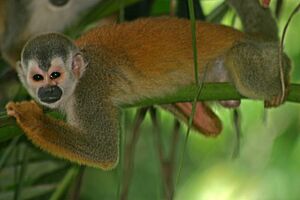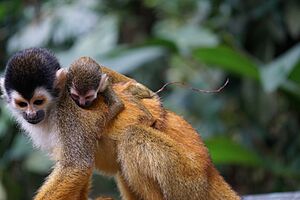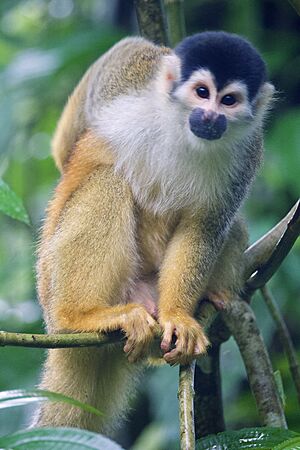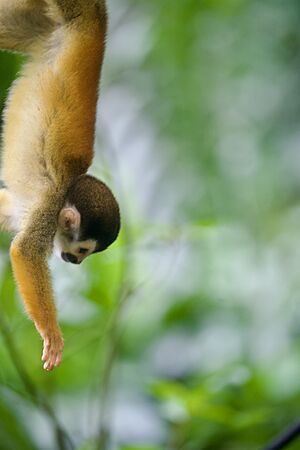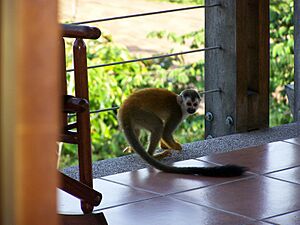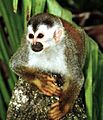Central American squirrel monkey facts for kids
Quick facts for kids Central American squirrel monkey |
|
|---|---|
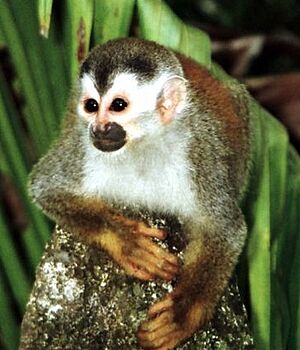 |
|
| Conservation status | |
| Scientific classification | |
| Genus: |
Saimiri
|
| Species: |
oerstedii
|
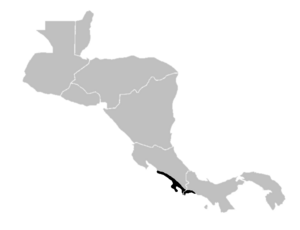 |
|
| Distribution of Saimiri oerstedii | |
The Central American squirrel monkey (Saimiri oerstedii), also called the red-backed squirrel monkey, is a small monkey found along the Pacific coast of Costa Rica and Panama. These monkeys live in specific areas, mainly in the northwestern part of Panama near Costa Rica, and along the central and southern Pacific coast of Costa Rica. You can often spot them in places like Manuel Antonio National Park and Corcovado National Park.
This monkey is quite small. It has a bright orange back and a unique white and black face that looks like a mask. Central American squirrel monkeys eat many different things, including fruits, plants, insects, and even small animals. They also have natural enemies like raptors (birds that hunt), cats, and snakes. They live in large groups, usually with 20 to 75 monkeys.
These monkeys have a very fair social system. Female monkeys do not try to be bossy over each other. Male monkeys only form a pecking order during the time they breed. Females can have babies when they are about 2 and a half years old. Males are ready to breed when they are 4 to 5 years old. Young adult females leave their birth group, but males often stay with their family group for their whole lives. Central American squirrel monkeys can live for more than 15 years.
Sadly, the number of Central American squirrel monkeys has dropped a lot since the 1970s. This is mainly because their forest homes are being cut down. People also used to hunt them or catch them to keep as pets. Many people are now working hard to protect these special monkeys.
Contents
About the Central American Squirrel Monkey
What Kind of Monkey Is It?
The Central American squirrel monkey belongs to the Cebidae family. This family includes many New World monkeys, such as capuchin monkeys, tamarins, and marmosets. Within this family, it is part of the squirrel monkey group, called Saimiriinae. It is one of five types of squirrel monkeys in the world. It is also the only squirrel monkey species that lives outside of South America.
All squirrel monkeys are in the genus Saimiri. The Central American squirrel monkey is most closely related to the Guianan squirrel monkey and the bare-eared squirrel monkey. These three species form a special group. The scientific name, Saimiri oerstedii, was given by Johannes Theodor Reinhardt. He named it after his fellow Danish scientist, Anders Sandøe Ørsted.
Different Types of Central American Squirrel Monkeys
There are two main types, or subspecies, of the Central American squirrel monkey:
- Black-crowned Central American squirrel monkey, Saimiri oerstedii oerstedii
- Grey-crowned Central American squirrel monkey, Saimiri oerstedii citrinellus
The S. o. oerstedii subspecies lives in western Panama and the Osa Peninsula area of Costa Rica. This includes Corcovado National Park. The S. o. citrinellus subspecies lives in the Central Pacific part of Costa Rica. Scientists estimated in 2003 that there were only about 1,300 to 1,800 S. o. citrinellus monkeys left in the wild.
Physical Features
The Central American squirrel monkey looks different from squirrel monkeys in South America. South American squirrel monkeys are mostly green. But the Central American species has an orange back. Its shoulders, hips, and tail are olive-colored, and its belly is white. Their hands and feet are also orange. They have a black cap on top of their head and a black tip on their tail. Male monkeys usually have lighter caps than females. Their face is white with black rings around their eyes and black fur around their nose and mouth.
The two subspecies look similar in color. However, their caps are different shades. The northern subspecies, found in Central Pacific Costa Rica, has a lighter cap. The southern subspecies, which lives in Panama and parts of Costa Rica near Panama, has a darker cap. The southern type also has more yellowish limbs and underparts.
Adult monkeys are about 26.6 to 29.1 centimeters (10.5 to 11.5 inches) long, not including their tail. They weigh between 600 and 950 grams (21 to 34 ounces). Their tail is longer than their body, measuring about 36.2 to 38.9 centimeters (14.25 to 15.3 inches). Male monkeys are usually bigger than females. On average, males weigh 16% more. Males weigh about 829 grams (29.2 ounces), and females weigh about 695 grams (24.5 ounces).
Squirrel monkeys have the largest brains of all primates compared to their body size. The Central American squirrel monkey's brain weighs about 25.7 grams (0.9 ounces). This is about 4% of its body weight. Unlike larger monkeys such as capuchin monkeys or spider monkeys, their tail cannot fully grasp things, except when they are newborn babies. The tail is mostly used to help them balance when they move.
Behavior and Lifestyle
Social Life
Central American squirrel monkeys live in trees and are active during the day (diurnal). They usually move through the trees on all four legs. They live in groups that include several adult males, adult females, and young monkeys. Their groups are usually smaller than those of South American squirrel monkeys. However, they are still larger than many other New World monkey groups. A typical group has between 20 and 75 monkeys, with an average of 41. Sometimes, groups of over 100 monkeys are seen, but these are likely two groups temporarily joining together. On average, groups have about 60% more females than males.
These monkey groups use an area of about 35 to 63 hectares (86 to 156 acres) as their home range. Different groups' ranges can overlap, especially in large protected areas like Manuel Antonio National Park. They travel between 2,500 and 4,200 meters (8,200 to 13,800 feet) each day. Unlike some other monkey species, their group does not split up to find food during the day. Individual monkeys might leave the main group for a short time to do different things. The whole group might spread out over an area of up to 1.2 hectares (3 acres) at any given time. They tend to sleep in the same trees every night for months, which is different from other squirrel monkeys.
Female Central American squirrel monkeys do not have a pecking order, and they do not form alliances against each other. Males in a group are usually related. They tend to form strong friendships. Males only create a pecking order during the breeding season. This is especially true for males of the same age. Neither males nor females are dominant over each other. This fair social system is special to Central American squirrel monkeys. In South American species, either females or males are dominant, and both sexes have clear pecking orders. Groups of Central American squirrel monkeys usually do not fight with each other. Male Costa Rican squirrel monkeys are known to have very strong bonds.
South American squirrel monkeys often travel and eat with capuchin monkeys. However, the Central American squirrel monkey rarely hangs out with the white-headed capuchin. This is because the food the Central American squirrel monkey eats is spread out in smaller patches. So, being with capuchin monkeys would make it harder for them to find enough food. Also, male white-headed capuchins focus more on finding rival males than on spotting predators. This means that being with capuchins would not help the Central American squirrel monkey much with predator detection.
Sometimes, Central American squirrel monkeys travel near mantled howler monkeys, especially if the howlers are making loud calls. But they do not usually touch or interact with them. Variegated and red-tailed squirrels might join the monkey groups without bothering them.
Certain bird species also follow Central American squirrel monkeys. These birds try to catch insects and small animals that the monkeys stir up. In Corcovado National Park, birds like the double-toothed kite, grey-headed tanager, and tawny-winged woodcreeper often follow the monkeys. Other woodcreepers, motmots, and trogons do this too. This behavior increases during the wet season when insects are harder to find.
What They Eat
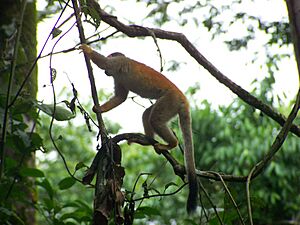
The Central American squirrel monkey eats both plants and animals (omnivorous). Their diet includes insects and their larvae (like grasshoppers and caterpillars), spiders, fruits, leaves, bark, flowers, and nectar. They also eat small animals like bats, birds, lizards, and tree frogs. They find their food by searching through the lower and middle parts of the forest, usually between 4.5 and 9 meters (15 and 30 feet) high. They spend two-thirds to three-quarters of each day looking for food. It can be hard for them to find enough food late in the wet season when fewer insects are available.
They have a special way of catching tent-making bats. They look for bats resting in their "tents," which are made from folded leaves. When a monkey finds a bat, it climbs higher and jumps onto the leaf tent from above. It tries to knock the bat out. If the bat falls and does not fly away fast enough, the monkey pounces on it and eats it.
The Central American squirrel monkey helps spread seeds and pollinate certain flowers, like the passion flower. While they do not usually cause problems for farms, they sometimes eat corn, coffee, bananas, and mangos. Other fruits they enjoy include cecropias, legumes, figs, palms, cerillo, quiubra, yayo flaco, and wild cashew fruits.
How They Communicate
Central American squirrel monkeys are quite noisy. They make many squeals, whistles, and chirps. They also make noise as they move through the forest, rustling the plants. They have four main calls: a "smooth chuck," a "bent mask chuck," a "peep," and a "twitter."
Who Hunts Them?
Predators of the Central American squirrel monkey include birds of prey, cats, and snakes. Both snakes that squeeze their prey and venomous snakes hunt squirrel monkeys. Birds of prey are especially good at catching them. The oldest male monkeys are usually the ones who watch out for predators the most. When a Central American squirrel monkey sees a raptor, it makes a high-pitched alarm peep and quickly hides. All other squirrel monkeys who hear the alarm also hide. These monkeys are very careful about raptors. They give alarm calls when they see anything that looks like a raptor, even small airplanes or falling branches and large leaves.
Males watching for predators is very important when baby monkeys are born. Raptors spend much more time near the monkey groups during this period. They hunt many newborn infants. Other animals that prey on baby Central American squirrel monkeys include toucans, tayras, opossums, coatis, snakes, and even spider monkeys.
Reproduction and Life Cycle
The breeding season for the Central American squirrel monkey is in September. All females are ready to breed at almost the same time. A month or two before breeding begins, males get bigger. This is not because of more muscle, but because their body holds more water. This happens when a male hormone called testosterone changes into estrogen. So, the more testosterone a male produces, the more he grows before the breeding season. Males in a group are not seen fighting over females during this time. This suggests that females choose which males they want to breed with. Females tend to prefer the males that grow the most before breeding season. This might be because the biggest males are usually the oldest and best at spotting predators.
Sometimes, males leave their group for short periods during the breeding season. They do this to try and mate with females from nearby groups. Females are open to males from other groups, even though the males already in the group try to chase away the newcomers. Pregnancy lasts for six months. The babies are born within a single week during February and March. Usually, only one baby is born at a time.
Only about half of the baby monkeys survive for more than six months. This is mostly due to birds of prey. The baby stays dependent on its mother for about one year. Females give birth every 12 months. So, the older baby becomes independent around the same time a new baby is born. Females are ready to have babies at about 2 and a half years old. Males are ready between 4 and 5 years old. Females leave their birth group when they become adults. Males usually stay with their group for their whole lives. This is different from South American squirrel monkey species, where either males leave their group or both sexes do. Males of the same age tend to stick together in groups. When they become adults, a group of same-aged males might leave their group. They might try to take over another group to have more chances to breed.
We do not know exactly how long Central American squirrel monkeys live in the wild. But monkeys kept in zoos have lived for more than 15 years. Other squirrel monkey species are known to live for over 20 years.
Where They Live and Their Home
The Central American squirrel monkey lives in a small area in Costa Rica and Panama. They only live near the Pacific coast. Their range goes from Central Pacific Costa Rica in the north down through western Panama. You can see them in two of Costa Rica's national parks: Manuel Antonio National Park and Corcovado National Park. However, they are not as easy to spot as the white-headed capuchin or mantled howler monkeys in these parks. They live in lowland forests. They prefer secondary forests (forests that have grown back after being cut) and primary forests that have been partly logged. They need forests with lots of low and mid-level plants. They find it hard to survive in tall, old, undisturbed forests that do not have much undergrowth. Their need for coastal lowland forests might explain why they live in such a small area.
Protecting the Species
For a long time, people thought the Central American squirrel monkey was just a group of South American squirrel monkeys brought to Central America by humans. This idea came from their very small living area and the large gap between them and any other squirrel monkey species. However, studies of their DNA showed that the Central American squirrel monkey is indeed a separate species. It seems they split off from the South American species a very long time ago. Some scientists think this happened at least 260,000 years ago, and possibly more than 4 million years ago. A genetic study in 2015 estimated they separated from S. sciureus a little less than 1 million years ago.
One popular idea is that squirrel monkeys lived in Colombia a long time ago. These monkeys then moved to Central America. They became the ancestors of the Central American species we see today. According to this idea, the Guatemalan black howler also moved to Central America around the same time. Later, the land bridge connecting North and South America closed due to rising oceans. It then opened again about 2 million years ago. New monkeys, like the ancestors of modern white-headed capuchins, mantled howlers, and Geoffroy's spider monkeys, migrated then. These later migrants might have been better at competing for resources. This could explain why the Central American squirrel monkey and Guatemalan black howler now live in such small areas.
Scientists have estimated that there are about 36 monkeys per square kilometer (93 per square mile) in Costa Rica. In Panama, there are about 130 monkeys per square kilometer (337 per square mile). It is believed that the number of Central American squirrel monkeys has dropped from about 200,000 in the 1970s to less than 5,000 today. This decline is mainly due to deforestation (forests being cut down), hunting, and being caught for the pet trade. There are big efforts in Costa Rica to save this monkey from disappearing. A project in Panama is also working to replant forests to help the vanishing population in the Chiriqui Province.
As of 2021, the IUCN lists the Central American squirrel monkey as an endangered species. This means they are at high risk of extinction. The main reason for this is the ongoing loss of their habitat due to deforestation. Other factors, like being captured for the pet trade, also contribute to their decline.
Images for kids




